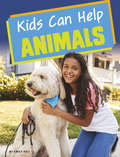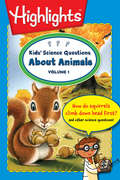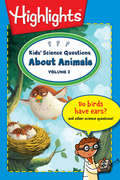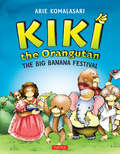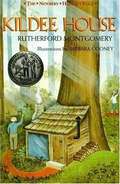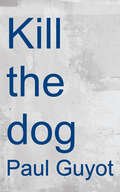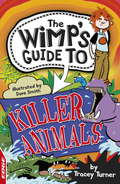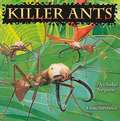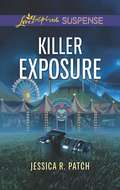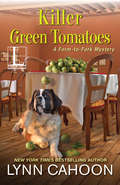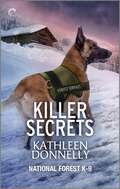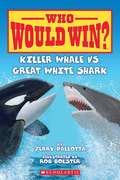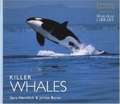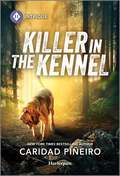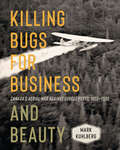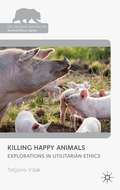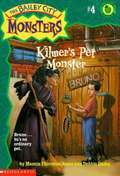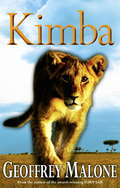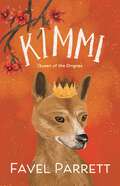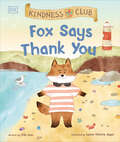- Table View
- List View
Kids Can Help Animals (Kids Can Help)
by Emily RaijMake the world a better place for animals! This book is full of ideas and projects readers can put into action to help animals.
Kids' Science Questions About Animals Volume 1
by Highlights For Children Debbie Palen Dave KlugJam-packed with questions and answers, this book and its companion, Kids' Science Questions About Animals: Volume 2, will entertain budding scientists who love to wonder why animals behave the way they do.
Kids' Science Questions About Animals Volume 2
by Highlights For Children Dave Klug Xiao XinJam-packed with questions and answers, this book and its companion, Kids' Science Questions About Animals: Volume 1, will entertain budding scientists who love to wonder why animals behave the way they do.
Kiki the Orangutan
by Arie KomalasariKiki is bored. And hungry! His family is busy, he wants to play, but no one has the time. So Kiki goes for a walk...and that's where all the trouble begins!Kiki the Orangutan is the charming tale of a naughty but good-natured orangutan who simply cannot resist stealing a bunch of ripe bananas from his neighbor's tree. After he has eaten them, however, he finds out that the bananas were going to be used to make banana bread-his favorite food-for the Banana Festival the next day. Now his poor neighbor has no bananas left to make any bread! Can Kiki make up for his actions and find a new bunch of bananas in time?
Kiki the Orangutan
by Arie KomalasariKiki is bored. And hungry! His family is busy, he wants to play, but no one has the time. So Kiki goes for a walk...and that's where all the trouble begins!Kiki the Orangutan is the charming tale of a naughty but good-natured orangutan who simply cannot resist stealing a bunch of ripe bananas from his neighbor's tree. After he has eaten them, however, he finds out that the bananas were going to be used to make banana bread-his favorite food-for the Banana Festival the next day. Now his poor neighbor has no bananas left to make any bread! Can Kiki make up for his actions and find a new bunch of bananas in time?
Kildee House
by Rutherford MontgomeryWhen Jerome Kildee, a solitary man, builds a home in a redwood forest in California, he takes in some skunks and raccoons, but as they begin to multiply, Kildee looks to two human neighbors for help. <P><P> Newbery Honor Book.
Kill the Dog: The First Book on Screenwriting to Tell You the Truth
by Paul GuyotKill the Dog is the first book on screenwriting written by an actual working professional screenwriter. Award-winning screenwriter Paul Guyot exposes the lies other screenwriting books have told, and presents authentic, essential instruction and motivation for anyone wanting a career as a professional screenwriter. This book provides all the answers, from what producers and studios actually want, to what makes one screenplay better than another, to why so many have been doing it wrong for so long. The author takes us inside the exclusive members-only world of professional screenwriters, from television writers rooms to meetings with producers and studio executives, to facts about formatting, structure, craft, art, and voice. <p><p>Every aspect of screenwriting is covered with an authority and credibility never seen in any book to come before. Told with honesty, humor, and vulnerability from the real-world perspective of a working, professional screenwriter, Kill the Dog reveals the secrets of what it takes to have a successful career as a Hollywood screenwriter.
Killer Animals (EDGE: The Wimp's Guide to #1)
by Tracey TurnerHave you ever:Wrestled a crocodile?Dived with great white sharks?Had a tarantula walk on your hand?If you answered NO to all of the above then this is the book for you!Are you a scaredy cat? Perfect! Feel frightened of animals? Woohoo! Inside you can read about loads of crazy stuff and how to survive - or avoid it.Love you inner wimp!Inside:Deadly Land Predators - Polar Bears, Lions, Tigers, Snakes, HippopotamusesUnder Water Killers - Sharks, Box Jellyfish, CrocodilesTiny Assassins - Mosquitos, Spiders, ScorpionsThis title is published by Franklin Watts EDGE, which produces a range of books to get children reading with confidence. We believe this title will be of interest to readers aged 7+ and to older readers who struggle with reading.EDGE - for books kids can't put down.
Killer Animals: The Wimp's Guide to:
by Tracey TurnerHave you ever:Wrestled a crocodile?Dived with great white sharks?Had a tarantula walk on your hand?If you answered NO to all of the above then this is the book for you!Are you a scaredy cat? Perfect! Feel frightened of animals? Woohoo! Inside you can read about loads of crazy stuff and how to survive - or avoid it.Love you inner wimp!Inside:Deadly Land Predators - Polar Bears, Lions, Tigers, Snakes, HippopotamusesUnder Water Killers - Sharks, Box Jellyfish, CrocodilesTiny Assassins - Mosquitos, Spiders, ScorpionsThis title is published by Franklin Watts EDGE, which produces a range of books to get children reading with confidence. We believe this title will be of interest to readers aged 7+ and to older readers who struggle with reading.EDGE - for books kids can't put down.
Killer Ants
by Nicholas NirgiotisDeep in a tropical forest, a million soldiers are on the march. They hold their heads high. Their huge hooked jaws are wide open. They are ready to do battle.
Killer Exposure: Act Of Valor Running Target Killer Exposure (Mills And Boon Love Inspired Suspense Ser.)
by Jessica R. PatchA killer with a secret motive…A mother with a secret babyCrime scene photographer Greer Montgomery didn’t expect to witness a murder at a small-town carnival—nor to be rescued by the father of her secret baby. A storm chaser, Locke Gallagher often stares down death, but he’s never known true fear until Greer’s life is at risk. But how can he protect his newly discovered family when the killer could be anyone?
Killer Green Tomatoes (A Farm-to-Fork Mystery #2)
by Lynn CahoonAn Idaho restaurant is ripe for success until the tomato supplier is accused of murder in this cozy mystery by the New York Times bestselling author. To Angie Turner, nothing tastes more like summer than her Nona's fried green tomatoes. Eager to serve the dish at her new farm-to-table restaurant, she's found the perfect produce supplier—her sous chef Estebe&’s cousin, Javier. But her hopes are crushed when Javier&’s new girlfriend turns up dead and the police name him as their prime suspect.Meanwhile, Angie&’s in quite a pickle trying to choose between the romantic interests of Estebe and Ian, the owner of the local farmer's market. But between managing her restaurant and navigating a new love triangle, she&’s determined to dig up evidence and catch the real killer before her favorite tomato farmer gets fried.
Killer Secrets (National Forest K-9 #3)
by Kathleen DonnellyA small town&’s deadly past is exposed in the newest installment of the suspenseful National Forest K-9 series by Kathleen Donnelly. Until an avalanche ripped down a mountainside, exposing a serial killer&’s dumping grounds, Antler Valley, Colorado, was a quiet town. Now Forest Service officer Maya Thompson and her beautiful K-9, Juniper, must catch the murderer before they become the next targets. With the neighboring town&’s new overconfident sheriff deterring the entire investigation, a murderer on the loose and heartthrob deputy Josh Colton racing through her mind, Maya is at a crossroads. Josh is ready to go all in, but Maya has one foot out the door. As she lets her guard down, she needs to accept that she&’s falling deeply in love with him, no matter how risky it may be. When evidence from the Antler Valley victims links the murders to deaths in other ski towns, secrets long buried are unearthed. Maya and Juniper must run toward an answer, though finding it might lead them directly into a fatal trap…National Forest K-9Book 1: Chasing JusticeBook 2: Hunting the TruthBook 3: Killer Secrets
Killer Whale Vs. Great White Shark (Who Would Win?)
by Jerry Pallotta Rob BolsterThis nonfiction reader compares and contrasts two ferocious underwater creatures. Kids learn about the killer whale and the great white shark's anatomies, behaviors, and more. This book is packed with photos, charts, illustrations, and amazing facts.
Killer Whales (Worldlife Library)
by Sara Heimlich James BoranKiller whales are the supreme predators in the ocean. Today we are learning to respect them as intelligent and adaptable animals, rather than fear them as the loathsome creatures once imagined in legends. This revised and updated introduction to killer whales, or orcas, pieces together the latest information on how they live. We learn how they communicate and maintain well-established societies, with intricate family relationships, over long lifespans. We also learn about the environmental concerns that threaten killer whales. Illustrated by the world's best wildlife photographers, this book brings us face to face with these intriguing creatures. This is the revised edition.
Killer Whales and Other Toothed Whales (World book's Animals of the World)
by Julie A. FentonThis new series of books tries to tell about animals in a fun and interesting question and answer format. Which whale is completely white? Why do Killer whales look the way they do? What is the life like for a Killer Whale? How do Dolphins Hunt? What is the difference between a dolphin and a porpose?
Killer Whales: Animal Predators
by Sandra MarlkeSome of the fiercest and most skilled hunters in the world, killer whales use teamwork and a strong sense of hearing and sight to track and kill their prey. Watch these huge animals as they grow from small pups into full-grown whales--honing the instincts and skills they'll need to become resourceful predators.
Killer in the Kennel: A Thrilling K-9 Romantic Suspense Book (South Beach Security: K-9 Division #3)
by Caridad PiñeiroHer K-9 found the victims. Can they find the killer?Determined to make his own way, Jose Gonzalez wants no part of the family business. Helping South Beach Security find land for its growing K-9 division should be easy, though—and working alongside search-and-rescue specialist Sara Hernandez is an unexpected perk. When her bloodhound detects two bodies on the property he purchased, everything changes. Jose will be a part of SBS until he&’s certain that Sara is safe. He knows that their attraction is mutual, but will the serial killer they&’re tracking rob them of a future together? From Harlequin Intrigue: Seek thrills. Solve crimes. Justice served.Discover more action-packed stories in the South Beach Security: K-9 Division series. All books are stand-alone with uplifting endings but were published in the following order: Book 1: Sabotage OperationBook 2: Escape the EvergladesBook 3: Killer in the KennelBook 4: Danger in Dade
Killing Bugs for Business and Beauty: Canada’s Aerial War against Forest Pests, 1913–1930
by Mark KuhlbergKilling Bugs for Business and Beauty examines the beginning of Canada’s aerial war against forest insects and how a tiny handful of officials came to lead the world with a made-in-Canada solution to the problem. Shedding light on a largely forgotten chapter in Canadian environmental history, Mark Kuhlberg explores the theme of nature and its agency. The book highlights the shared impulses that often drove both the harvesters and the preservers of trees, and the acute dangers inherent in allowing emotional appeals instead of logic to drive environmental policy-making. It addresses both inter-governmental and intra-governmental relations, as well as pressure politics and lobbying. Including fascinating tales from Cape Breton Island, Muskoka, and Stanley Park, Killing Bugs for Business and Beauty clearly demonstrates how class, region, and commercial interest intersected to determine the location and timing of aerial bombings. At the core of this book about killing bugs is a story, infused with innovation and heroism, of the various conflicts that complicate how we worship wilderness.
Killing Happy Animals: Explorations in Utilitarian Ethics
by Tatjana VišakIs it acceptable to kill an animal that has been granted a pleasant life? This book rigorously explores the moral basis of the ideal of animal-friendly animal husbandry and sheds new light on utilitarian moral theory by pointing out the assumptions and implications of two different versions of utilitarianism, with surprising conclusions.
Kilmer's Pet Monster (The Bailey City Monsters #4)
by Debbie Dadey Marcia Thornton JonesKilmer Hauntly, who looks a lot like Frankenstein, is excited about the Bailey City Best Pet contest. His mysterious pet is unlike any creature the town has ever seen.
Kimba
by Geoffrey MaloneBorn among the rocks of M'goma Hill, Kimba is nurtured by his mother, fierce, tender Sabba. She teaches him the ways of the plains - the merciless hunt for food, the endless dangers from hyenas, leopards, crocodiles and rival lions. But when strange lions wrestle the pride away from his sire, Black Mane, Kimba must flee for his life to face the struggle for survival alone. Slowly, painfully, he grows fiercer and stronger: ready at last to challenge for leadership of his old pride and to confront lion's greatest enemy - humans.
Kimmi: Queen of the Dingoes
by Favel ParrettLONGLISTED FOR THE 2023 CHILDREN'S INDIE BOOK AWARDOn the night of a full moon, a small tropical dingo cub is born. And it is her destiny to travel far from home to change things for her kind.Kimmi sleeps with her mama at her back, her aunty at her front and her three brothers squeezed in beside her. They are a family. But when the farmer who took her father returns to threaten the rest of them, Kimmi is separated from her mama.In an incredible act of determination, Kimmi's mama runs over mountain tops and dusty red earth to spend one last day with her cub and share with her the knowledge that will one day make her a queen.This is Kimmi's story, the story of how she became Queen of the Dingoes in a sanctuary that saves them from extinction. It is her mama's story, too. But mostly it is a story that goes back thousands of years, and follows the long line of female dingoes they belong to.An inspiring true story of survival and courage from one of Australia's best-loved writers. 'Parrett blends matter-of-fact content with a confidently poetic voice . . . For readers aged 8+' BOOKS+PUBLISHING'A lyrically told tale of survival and resilience for younger readers' SATURDAY AGE
Kimmick Come Home: Written and Illustrated by Beverly Stevens
by Beverly StevensKimmick Come Home is a story of a young puppy who runs away because she thinks she is too funny-looking to be a famous sled dog like her Mom. But what can she be? Kimmick's journey takes her on many adventures, from outrunning a moose to rescuing herself from a rushing river—all under the watchful eye of “Magpie,” a wise bird who encourages Kimmick to go back home where she belongs. Kimmick learns that it's not how she looks on the outside that counts, but how she feels about herself on the inside that is important.
Kindness Club Fox Says Thank You (Kindness Club)
by Ella LawFollow Fox as she learns how important it is to show kindness and gratitude toward her friends.Fox is feeling grumpy. She doesn’t want to play with her friends and instead snatches away their ball and snacks. While her pals go on a boat trip, Fox runs off to her favorite place—the lighthouse— determined to have more fun on her own. However, when a storm breaks and Fox sees her friends’ boat battling with the waves, she realizes she needs to help. Will Fox be able to show how much she truly cares for her friends by saving the day?Children will love the myriad animal characters and learning and understanding the different ways we can be kind to one another. There are lots of extra learning opportunities, including questions about the story, activities such as how to make your own Kindness Badge, and notes for parents and caregivers to extend learning and reinforce positive behavior.In the words of Badger, who runs the Kindness Club, "When you show kindness, it makes you and your friends feel good."
